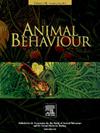Temperature affects conspecific and heterospecific mating rates in Drosophila
IF 2.3
2区 生物学
Q2 BEHAVIORAL SCIENCES
引用次数: 0
Abstract
Behavioural mating choices and mating success are important factors in the development of reproductive isolation during speciation. Environmental conditions, especially temperature, can affect these key traits. Environmental conditions can vary across, and frequently delimit, species’ geographical ranges. Pairing suboptimal conditions with relative rarity of conspecifics at range margins may set the stage for hybridization. Despite the importance of mating behaviours as a reproductive barrier, a general understanding of the interaction between behavioural choices and the environment is lacking, in part because systematic studies are rare. With this report, we begin to bridge that gap by providing evidence that temperature has a significant but inconsistent influence on mating choices and success and, thus, on reproductive isolation in Drosophila. We studied mating propensity and success at four different temperatures among 14 Drosophila species in no-choice conspecific mating trials and in heterospecific trials among two Drosophila species triads that are known to regularly hybridize in the wild. We found that mating frequency varied significantly across a 10 °C range (from 18 °C to 28 °C), both in 1:1 mating trials and in high-density en masse trials, but that the effect of temperature was highly species specific. We also found that mating frequency was consistently low and that temperature had a moderate effect on some heterospecific crosses. As conspecific mating propensity decreased outside of the optimal thermal range, while heterospecific matings remained constant, the proportion of heterospecific matings at suboptimal temperatures was relatively high. This result indicates that temperature can modulate behavioural choices that impose reproductive barriers and influence the rate of hybridization. More broadly, our results demonstrate that to truly understand how mating choice and reproductive isolation occur in nature, they need to be studied in an environmental context.
温度影响果蝇的同种和异种交配率
交配行为选择和交配成功是物种形成过程中生殖隔离发展的重要因素。环境条件,尤其是温度,会影响这些关键特征。环境条件可以在物种的地理范围内变化,并且经常划定物种的地理范围。配对次优条件与在范围边缘的同种的相对稀有性可能为杂交奠定了基础。尽管交配行为作为生殖障碍很重要,但对行为选择与环境之间的相互作用缺乏普遍的了解,部分原因是系统的研究很少。有了这份报告,我们开始通过提供证据来弥补这一差距,即温度对果蝇的交配选择和成功有显著但不一致的影响,因此,对生殖隔离也有影响。我们研究了14种果蝇在四种不同温度下的交配倾向和成功率,分别进行了无选择的同种交配试验和在两种已知在野外有规律杂交的果蝇三联体的异种交配试验。我们发现,在10°C的范围内(从18°C到28°C),无论是1:1的交配试验还是高密度的大规模试验,交配频率都有显著变化,但温度的影响是高度物种特异性的。我们还发现交配频率一直很低,温度对某些异种杂交的影响不大。在最佳温度范围外,由于同种交配倾向降低,而异种交配保持不变,因此在次优温度下,异种交配比例相对较高。这一结果表明,温度可以调节施加生殖障碍和影响杂交率的行为选择。更广泛地说,我们的研究结果表明,要真正理解交配选择和生殖隔离在自然界中是如何发生的,需要在环境背景下进行研究。
本文章由计算机程序翻译,如有差异,请以英文原文为准。
求助全文
约1分钟内获得全文
求助全文
来源期刊

Animal Behaviour
生物-动物学
CiteScore
4.60
自引率
8.00%
发文量
236
审稿时长
10.2 weeks
期刊介绍:
Growing interest in behavioural biology and the international reputation of Animal Behaviour prompted an expansion to monthly publication in 1989. Animal Behaviour continues to be the journal of choice for biologists, ethologists, psychologists, physiologists, and veterinarians with an interest in the subject.
 求助内容:
求助内容: 应助结果提醒方式:
应助结果提醒方式:


